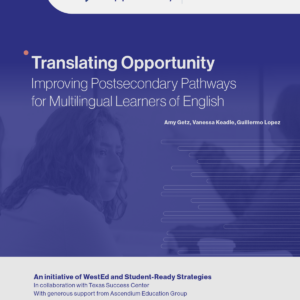Lessons From Multilingual Learners to Improve Student Success
Posted on

By Dr. Abbey Ivey and Amy Getz
WestEd and Student-Ready Strategies recently released a report highlighting how institutions and systems can better support Multilingual Learners of English (MLE) as they pursue postsecondary pathways. The report offers recommendations to more effectively and equitably serve these students, an often overlooked and underserved population in higher education.
There is much we can learn about how to support MLE students by listening directly to the students themselves. To broaden our understanding of MLE students’ experiences navigating postsecondary systems, we engaged in a series of interviews with students in English as a Second Language (ESL) programs in Texas and California. The learnings shared here reflect their critical perspectives and shed light on ways institutions can better meet the needs of MLE students.
MLE Students Value a Culture of Care
Perhaps the most resounding theme that surfaced during our conversations with MLE students is the importance of their relationships within the college community. There is ample research that underscores the significance of a sense of belonging for college students and the ties of that sense of belonging to academic success—defined by Terrell L. Strayhorn in College Students’ Sense of Belonging: A Key to Educational Success for All Students as “students’ perceived social support on campus, a feeling or sensation of connectedness, and the experience of mattering or feeling cared about, accepted, respected, valued by, and important to the campus community or others on campus such as faculty, staff, and peers.”
The critical nature of a sense of belonging was reflected in the interviewees’ remarks about their college experience. They all emphasized the kindness and understanding shown by their instructors, with one student noting that the staff at her college felt like family. Another reflected on her bond with her classmates, indicating, “I feel like I knew them already, a long time ago.” The importance of peer connection was highlighted by another student, who said she has made numerous friends from different countries and cultures in her ESL classes, noting, “We support each other because we know each other. . . . I experienced a lot of good memories with them.”
Ultimately, these relationships help to build the confidence of MLEs as they face the challenges associated with learning a new language and tackling coursework.
How Faculty and Staff Can Help
Professionals serving MLE students should provide intentional opportunities for MLE students to connect with each other and with the institution, such as creating learning communities and hosting social gatherings, and those opportunities should be communicated to students in a welcoming, straightforward way. One student in particular spoke about the benefits of the ESL learning community at her college and how having the same students in the ESL courses across semesters helped the students to feel more comfortable in class. She also noted that she was having dinner that evening with her ESL classmates to celebrate the end of the semester, further emphasizing the family-like environment she experiences in the program.
Institutional leaders must also provide support and guidance to ESL instructors to ensure they are equipped to engender a culture of care within their classrooms. This type of support may necessitate professional learning and/or policy shifts at the institution.
MLE Students Are Balancing Life and School
Like many adult learners, MLE students are often balancing life obligations with their studies. Recent research has found that MLE students are more likely to be employed full-time and to be supporting dependents while attending school compared to their non-MLE peers. The competition between parenting responsibilities and school requirements, in particular, was highlighted by these students as being one of their most significant challenges.
As one student noted while discussing the difficulties associated with managing her kids’ activities and attending class, “It’s so hard for me to catch up. Because sometimes I can’t attend Zoom class or sometimes I’m late.” Another student echoed this sentiment by saying, “Para mí fue, muy bonito y aprendí mucho, pero fue muy duro porque soy mamá y tengo muchas cosas que hacer y mucha tarea.” (“For me, it was very nice and I learned a lot, but it was very hard because I am a mother and I have many things to do, and there is a lot of homework.”) This struggle was again reflected in another student’s comments: “I’m a single mom, so it was really hard for me in the beginning. My parents helped me, but I need to work.”
These conflicting responsibilities can sometimes halt an MLE student’s progress on their postsecondary pathway, but here again, students cited the understanding and support of their instructors and other staff in helping to keep them moving forward. Flexibility is appreciated by the MLE students we spoke to, along with the knowledge that many of their instructors will grant students additional time to complete work. One student emphasized, “La maestra fue muy comprensiva y nos ayudaba mucho, nos daba tiempo.” (“The teacher was very understanding and helped us a lot. She gave us time.”)
How Faculty and Staff Can Help
It is important to keep in mind that these students often face additional challenges related to translation and comprehension when completing assignments in English that are unique to the MLE population, such as translating course content between English and their native language to aid their understanding of the material. One interviewee, who is enrolled in ESL courses while concurrently pursuing a major in psychology, discussed how she learns basic English terms in her ESL courses while at the same time learning more academic vocabulary in her psychology coursework. This student wanted to advise instructors to have patience when working with MLE students, emphasizing that sometimes MLE students may need things repeated to assist with comprehension and that displaying patience is very helpful to those students.
Institutional leaders should help all faculty implement instructional strategies that provide MLE students the time and support they need to reach their full potential. Again, this type of support will likely necessitate professional learning opportunities and policy shifts at the institution.
MLE Students Are Looking Toward the Future
The students who spoke with us had a strong sense of why they enrolled in ESL coursework and are pursuing a college education: their future. These students are looking to improve their English-speaking skills to help them at work or to pursue a new career entirely. One student specifically cited her desire to graduate in marketing and finance and get a better job. She said of her college, “Aquí en [college name], me han dado oportunidad de seguir, de que no es tarde para estudiar . . . para tener mejor un trabajo.” (“Here at [college name], they have given me the opportunity to continue, that it is not too late to study . . . to have a better job.”) Another student hopes to transfer to a university to complete her degree, emphasizing that she continues in school because she wants “a good future” for her daughter.
How Faculty and Staff Can Help
This sense of purpose points to the importance of providing clear pathways between ESL coursework and academic and workforce programs, and even contextualizing ESL coursework to specific disciplines. MLE students are often enrolled in higher education to seek a specific pathway to employment and economic mobility. Faculty and staff at institutions serving the MLE population should advocate to make that pathway as straightforward as possible.
The Bottom Line . . .
MLE students enter our institutions from various backgrounds and with varying levels of knowledge and comfort with English. They bring a unique and valuable set of experiences and assets to the campus community. Institutions that prioritize building genuine relationships with MLE students, develop flexible and understanding policies for students, and create clear pathways to student goals will go a long way in promoting successful postsecondary outcomes for MLE students.

